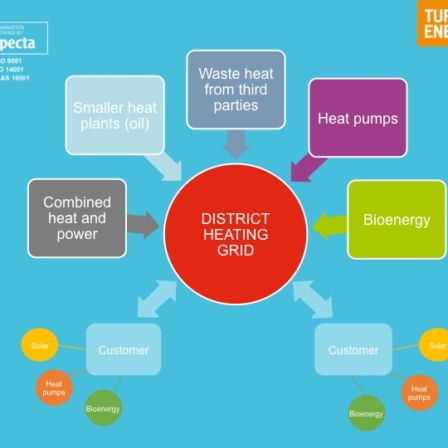According to a study commissioned by Finnish Energy (ET) and Sitra, there seems to be considerable demand for two-way district heating, allowing customers to both use and sell heat. The study found that such a two-way network can make effective use of small-scale production and that customers are interested in the development of district heating products and network use. Two-way district heating can also increase the energy efficiency of heating, reduce emissions and increase the competitiveness of district heating companies.
In a two-way network, customers can both purchase district heating and sell their own heat production or excess heat. Two-way district heating is one way to integrate conventional district heating production and distributed heat production solutions. For example, heat generated by solar collectors on an apartment block or industrial waste heat could be transmitted to the district heating network.
“The possibilities offered by two-way district heating vary considerably in different district heating systems,” explains Adviser Antti Kohopää of Finnish Energy (ET). “Different business models and contractual arrangements are suitable for different systems. Indeed, each district heating company should engage in an active dialogue with those customers who show interest in a two-way system. There are no technical obstacles to two-way district heating.”
Increasing efficiency and competitiveness – but also cost
A two-way system can make district heating more efficient and competitive when the owners of the district heating network can ensure that the value of their network is maintained far into the future and keep district heating as a desirable alternative to other types of heating.
A vital condition for increasing two-way district heating is that all parties benefit from it – customers, two-way district heating customer-producers and district heating companies. According to the report, increasing public awareness and the dialogue between potential two-way customer-producers and district heating companies are key to promoting this issue. Pilot sites are now needed in order to gather information on experiences with such a system.
“Two-way systems improve the opportunities to profitably integrate small-scale production with district heating systems, but they also require changes to and investments in the customers’ own systems,” says Leading Specialist Jaana Pelkonen of Sitra. “Indeed, this is the reason that two-way systems are easier to realise in new areas and new construction projects.”
The competitive pricing of small-scale production in relation to existing district heating production can be seen as a major practical challenge facing the significant expansion of two-way district heating. If the competitiveness of small-scale production improves in the future, it can be assumed that there will be an increase in two-way district heating too.
For further information:
Adviser Antti Kohopää, Finnish Energy, tel. +358 (0)50 301 1870, firstname.lastname@energia.fi
Leading Specialist Jaana Pelkonen, Sitra, tel. +358 (0)40 540 9775, firstname.lastname@sitra.fi







Recommended